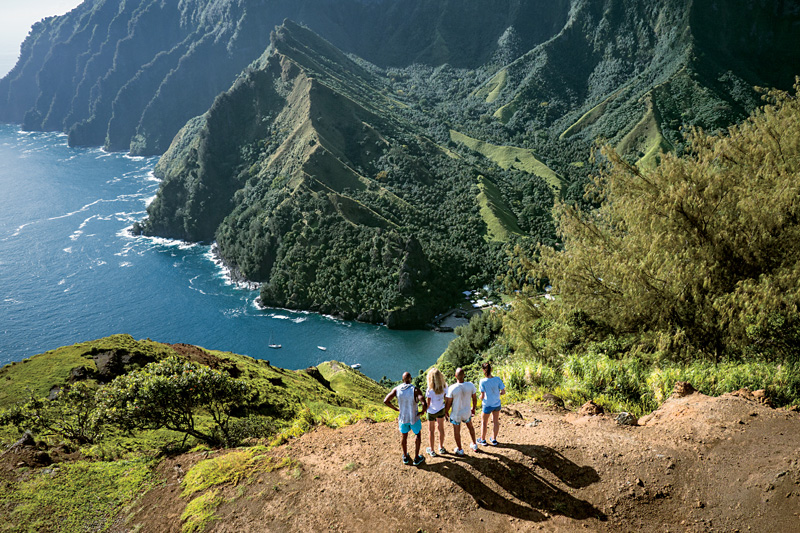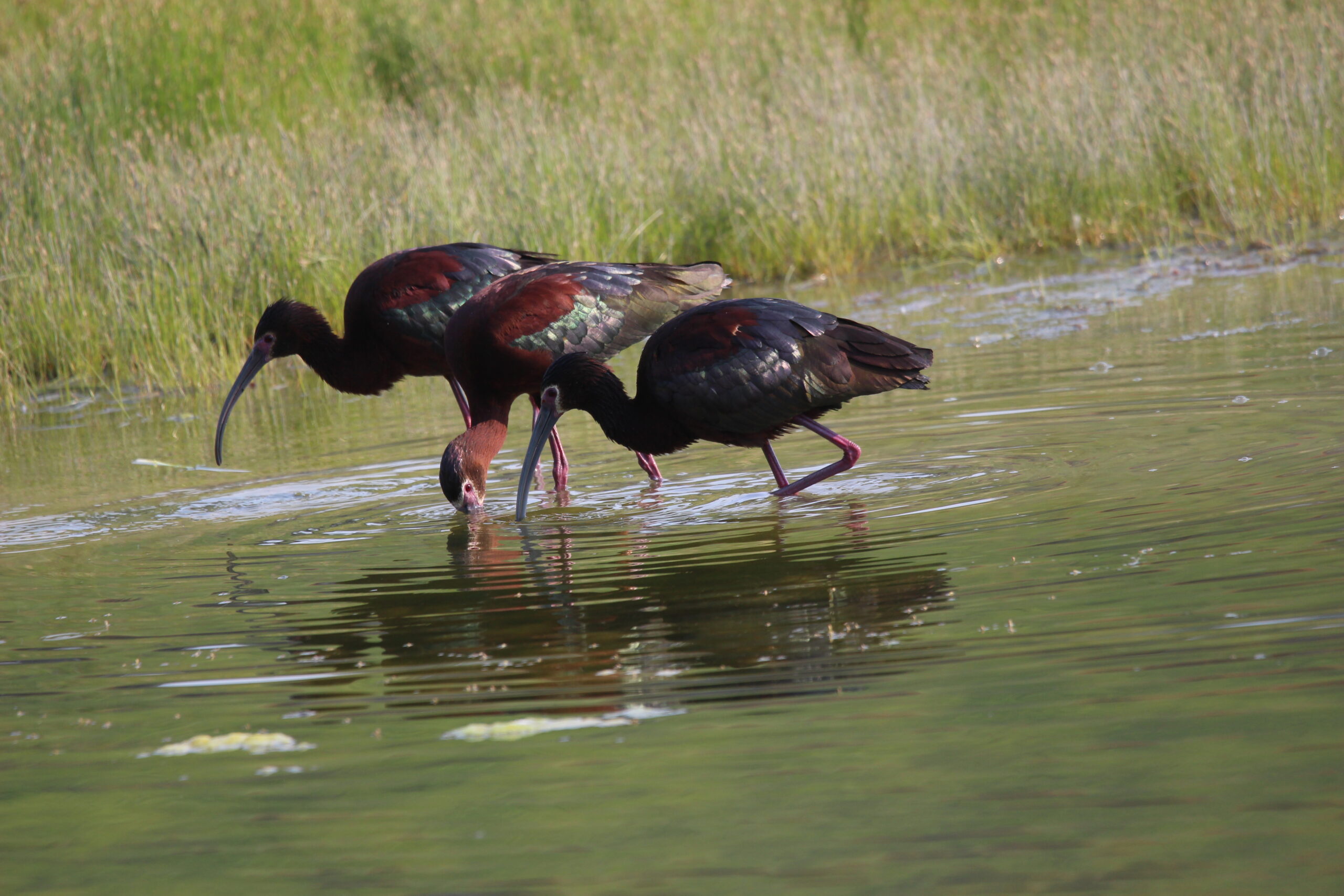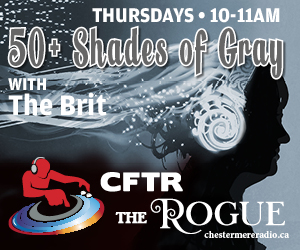Although it is getting closer and closer to warm weather here in Calgary, these cold windy days still have me dreaming of beautiful warm beaches. Experiencing a night in an overwater bungalow in Bora Bora has been a lifelong dream, always near the top of my bucket list, so this week let me tell you what I’ve learned about that area of the world.
Stretching nearly 65 million square miles over the surface of the Earth, the Pacific Ocean is the world’s largest body of water. Check out this video with aerial views of the various islands. The 118 islands and atolls of French Polynesia lie in the middle of the South Pacific, surrounded by pristine bays and lagoons in a stunning rainbow of blues. Many islands are still sparsely populated and remain mysterious and intriguing even today. Known collectively for their largest and most populous island, Tahiti, these exquisite islands each have their own distinctive beauty, atmosphere, and myth and are some of the most beautiful and coveted islands in the world.
French Polynesia is a year-round destination, averaging nearly 3,000 hours of sunshine per year, making these islands among the sunniest in the world. They enjoy a pleasant tropical climate that averages 79°F year-round, and the average water temperature in the lagoons is a fairly constant 80°F.
Because these islands lie south of the equator, the seasons are reversed, Summer (November to March) is warm, humid, and often sunny. Winter (April to October) is typically warm and sunny. In French Polynesia you will also have the opportunity to gaze at stars and constellations that are visible only in the Southern Hemisphere.
There are several groups of islands including the Society Islands, the Tuamotu Archipelago, the Cook Islands, the Marquesas Islands, Tonga, and Fiji. Since 2003, French Polynesia has been an overseas collectivity of the French Republic.
TAHITI & THE SOCIETY ISLANDS
The most famous of French Polynesia’s island groups, the awe-inspiring Society Islands, form the most popular destination for most travellers. Sometimes referred to collectively as “Tahiti,” the name of their largest and most populous island, these islands are beloved for the jaw-dropping scenic splendor of their mountainous interiors, deep verdant valleys, clear streams, high waterfalls, rugged coastlines, and abundance of tropical flowers.
Papeete is where many French Polynesia itineraries begin and/or end. Located 15 minutes north of the airport on the island of Tahiti, Papeete is the capital city of French Polynesia and is a colourful blend of cultures, with fine restaurants and cafés, small nightclubs, and shopping at the vibrant markets, boutiques, and pearl shops.
BORA BORA
With a lagoon resembling an artist’s palette of blues and greens, and castle-like Mount Otemanu piercing the sky, the island of Bora Bora has inspired romantics from around the world. Lush tropical slopes and valleys blossoming with hibiscus delight the eye, while palm-covered islets circle the illuminated lagoon like a delicate necklace. Perfect white-sand beaches give way to emerald waters where colourful fish animate the coral gardens as they greet giant manta rays. No wonder this idyllic coastline has attracted visitors for centuries.
The island lies 150 miles northwest of Tahiti in the Society Islands. Bora Bora’s main island, home to over 4,000 inhabitants, is in the center of the lagoon and surrounded by offshore isletsinside a protective coral necklace. A partially paved road circles the island, passing colorful villages, and archaeological sites.
HUAHINE
One of the most picturesque and geographically diverse islands in the Society Islands group and one of the best-kept secrets in all of Polynesia, Huahine has been nicknamed the “Garden Island” for its lush forests, untamed landscape, and quaint villages. Enclosed in a single lagoon, it actually consists of two islands: Huahine Nui (“Big Huahine”) and Huahine Iti (“Little Huahine”). Many believe that Mt. Tavaiura on Huahine Nui’s Fitii Peninsula resembles a women’s face, leading to her chest and her round belly, which explains Huahine’s original name (literally, “pregnant woman”).
Located 109 miles northwest of Papeete, Huahine is home to more than 200 pre-European stone ancient temple sites, the largest concentration of such sites in these islands. The island’s fertile soil provides bountiful harvests of a variety of melons as well as other fruits and vegetables. Small villages and untouched beaches dot the coast, and azure lagoons brim with thousands of colorful fish. A deep, crystal-clear lagoon surrounds the two islands, while magnificent bays and white-sand beaches add drama. Relatively unchanged by the modern world, Huahine offers a slower-paced taste of old Polynesia.
MOOREA
Rugged peaks, volcanic craters, and lush interiors thick with tropical fruit, fragrant flowers, and forests of gigantic mape, or chestnut trees, make the mountain scenery of Moorea nothing short of remarkable. Polynesian legend describes its panorama of volcanic ridges as the second dorsal fin of the fish that became the island of Tahiti, just 11 miles away. These peaks are also believed to have inspired the mythical Bali Hai of the musical South Pacific, which was based on James A. Michener’s book, Tales of the South Pacific.
On this picture-postcard tropical island, poetic threads of waterfalls tumble down fern-softened cliffs. Peaceful meadows flanked by pinnacles of green renew a belief in the majesty of nature. Sharp volcanic peaks rise from the horizon, crowned by pearly clouds, and reflected in the waters of Cook’s Bay and Opunohu Bay. Picturesque villages of pastel houses surrounded by gardens of hibiscus and Birds of Paradise dot the island’s interior. Shark sightings on nearly every dive in Moorea’s wide, shallow lagoon make this island a popular diving destination. At times, a tuna will come by, or dolphins can be heard clicking, just out of sight.
TAHA’A
About 80% of all vanilla produced in French Polynesia is cultivated in Taha’a, fittingly nicknamed the “Vanilla Island.” Unlike large-scale plantations, most vanilla farms are small, family-run operations, so much of the island remains unspoiled, and the scent of the bean is in the air. Time seems to stand still here, as the people practice ancestral methods of fishing, canoeing, and farming, offering a glimpse of the traditional and tranquil life of the Tahitians. As a result, it is an ideal escape. Taha’a is located just about two miles north of Raiatea, the cultural, religious, royal, and political heart of Polynesia and home to the Society Islands’ most significant archaeological sites. The two sister islands are enclosed by a common lagoon. Accessible only by boat, Taha’a is the only Society Island that can be completely circled by ship inside the protected lagoon.
TUAMOTU
The largest atoll of the Tuamotu archipelago, Rangiroa is also the largest atoll in the Southern Hemisphere, the second-largest atoll in the world, and one of the world’s greatest dive destinations. Sometimes referred to as “the Island of the Long Sky,” Rangiroa is an impressive sight viewed from the air, with its string of 240 coral islets encircling a 400-square-mile turquoise and jade-green lagoon. Home to dolphins, rays, and myriad colorful tropical fish, this sheltered lagoon is referred to as “God’s Aquarium” by expert divers. The atoll’s interior lagoons are a haven for black pearl farms, fish breeding farms, snorkeling, and SCUBA diving.
MARQUESAS
A part of French Polynesia, yet a world apart, the remote Marquesas lie shrouded in mystery, with their mist-laden mountains and untouched wilderness. The very isolation of this mystical island group has infused it with a unique language and thousand-year-old culture and unspoiled landscape. On these rugged islands you’ll find waterfalls, wild stallions, tiki sculptures, and an arboretum, among other delights. Located between Tahiti and Hawaii, this isolated realm proudly retains its ancient language and culture, as well as the spellbinding beauty that inspired artist Paul Gauguin to call these islands home.
The southernmost island in the Marquesas, Fatu Hiva, may also be the most beautiful. This remote paradise has just one road, no airstrip, and only 500 residents. A century ago, the island was known as a haven for sailors seeking to avoid the attention of the authorities. Today, it’s known for the production and sale of tapa, a traditional Marquesan handicraft of beaten bark cloth decorated with ink.
Nuku Hiva, the largest of the Marquesas Islands, is accented with a mountain range dominated by Mt. Tekao. It also boasts a central plateau of pasture, agricultural fields, and forests, towering peaks, secluded valleys, and high waterfalls; and fjord-like bays, capes, rocky promontories, and cliffs.
COOK ISLANDS
Covering an area roughly the size of Western Europe, the Cook Islands were named in the early 1800s after the legendary British explorer, Captain James Cook. Today, the Cook Islanders are well- known for their traditional song, dance, and crafts such as tivaevae (intricate quilts inspired by nature), making these islands a repository for the authentic culture of the South Seas. They are also the quintessential tropical getaway.
The capital of the scattered nation of the Cook Islands, Rarotonga is a relaxing place of beauty and style. Its sparse population lives on the coast of the circular island, while the interior is lush, rugged, and jungle-clad, offering the opportunity for challenging walks and sensational views.
Villages, beaches, paw paw patches, and fields of taro, mango, bananas, and noni (an evergreen used for dyes, juices, and medicines) abound throughout the island, providing an instant study of local life.
According to legend, Ru, the famous Polynesian warrior, first saw the picturesque Cook Island of Aitutaki by moonlight and was so enchanted, he settled here and became the forefather of today’s Aitutakians. Certainly, the island has attracted many explorers since its Polynesian settlement around 900 AD. Captain William Bligh visited the island in 1789, shortly before the famous mutiny aboard the vessel he commanded, the Bounty.
Only eight square miles in area, this virtually flat island is revered today for its sweeping vistas and stunning scenery of white-sand beaches, for its coral reefs, and, most of all, for one of the most exquisite lagoons in the world.
FIJI
Blessed with blue skies, ivory beaches, and azure waters, Fiji is home to more than 300 islands, only about a third of which are inhabited. The very picture of paradise, these islands have served as the ultimate tropical setting for films from The Blue Lagoon to Cast Away. A British colony for nearly a century before gaining its independence in 1970, Fiji remains English speaking and today boasts a multinational population, among whom the majority are of Melanesian descent. Reputed to be among the friendliest people in the world, you’ll understand why virtually everyone you meet will be smiling as you view the high mountains, lush vegetation, shimmering waters, and pristine beaches of this island nation.
Located on the northwest coast of Viti Levu, the largest and most populous of the Fijian islands, is Lautoka, Fiji’s second-largest city. Virtually synonymous with the country’s main export, Lautoka is known as “Sugar City” for the green-gold sugarcane that covers it on three sides, with the beautiful blue Pacific Ocean forming its western border.
The island of Vanua Levu in northern Fiji remains largely undeveloped, making it a charming, unspoiled haven. It is the second largest of Fiji’s 300 islands, and, because of its remoteness, it is reminiscent of the South Seas before its discovery by Europeans. Largely unchanged over the past 30 years, the village of Savusavu is sometimes called the “Hidden Paradise of Fiji,” with its single, half-mile-long main street facing a fantastically beautiful bay. Hot springs bubble up throughout the town. In the afternoon, visitors can see pots atop steaming fissures as women prepare the evening meal.
The capital of Fiji since 1883, Suva is located on rugged Viti Levu, the largest of the island chain and home to 75% of the country’s population. Suva itself is the largest urban area in the South Pacific outside of Australia and New Zealand. It is also Fiji’s main port city and the commercial and political center of the nation. Perched on a hilly peninsula between two harbors, Suva boasts a fascinating mix of modern and colonial architecture, as well as an easygoing yet sophisticated ambiance.
TONGA
The Kingdom of Tonga, also known as “The Friendly Islands”, for the warm reception Captain Cook received on his first visit in 1773, is situated just west of the International Date Line. One of the easternmost countries in the world, it was never colonized, a distinction it shares with no other South Pacific nation. As a result, its culture remains strong, even in the face of modernization.
One of the Kingdom of Tonga’s three main island groups, the islands of Vava’u are renowned for their colourful coral reefs, white-sand beaches, and lagoon so clear, it is possible to see to a depth of 130 feet!
EXPERIENCES OF A LIFETIME
Although I know I could just sit back end enjoying the ocean views all day, there are lots of other things to experience! Here are a few of the excursions that caught my eye.
- On nearly every island there are off-road, four-wheel-drive excursions, to take you out into the islands and experience the rugged terrains.
- A must for me is to experience the dramatic splendor of Bora Bora from an overwater villa. A relaxing, romantic evening complete with champagne, aromatic flowers, your own view of the ocean.
- All ages can enjoy dozens of perfect snorkeling spots around the islands.
- On Moorea, assisted by a certified diving instructor, you can walk on the ocean floor at a depth of 12 feet, and see beautiful coral heads hosting an abundance of triggerfish, butterflyfish, groupers, parrotfish, and other fish species.
- Maybe you enjoy more cultural experiences. On Taha’a’s highest mountains, you can visit a scenic viewpoint, learn the traditional use of local plants and trees, and learn the tamure, a Tahitian dance.
- On Cook Island, discover the wisdom of Pa, one of the best-known healers, on an informative guided trek. You will learn about Pa’s knowledge of local plants, history, and culture, and see a demonstration of traditional medicinal preparations.
- Shopping for pearls, shell jewellery, vanilla and a variety of native textiles will entertain you as you visit the islands.
- You might want to try Shark and Ray Feeding. While the idea of feeding sharks may sound somewhat ominous at first, it is one of the most popular excursions in the South Pacific.
- A cool opportunity awaits in Bora Bora, where you can don a snorkeling mask and float in the shallow lagoon waters behind a secure rope. Docile sharks arrive in schools and are hand-fed by an expert guide just a few feet away.
- And there are world class diving opportunities everywhere. Called the “Soft Coral Capital of the World” by Jean-Michel Cousteau, Fiji offers some of the world’s best SCUBA diving, with a comprehensive range of excellent dive locations.
There are many cruise itineraries that stop at the islands, and, of course, you could decide to stay in one place and spend your entire vacation there. We recommend Paul Gauguin Cruises to our clients. As one of the highest-rated and longest continually sailing luxury cruise ships in the South Pacific, a memorable trip is guaranteed. With no more than 332 guests, all-inclusive pricing, and a full team of French Polynesia experts, including their onboard troupe of Tahitian host/entertainers, we think this is one of best way to travel among these beautiful islands. An added bonus is access to their private islet and private beach on Bora Bora!
Perhaps a 7-night cruise would be the perfect introduction to the picture-perfect charms of the South Pacific. You would experience Vanilla-scented Taha’a, rugged Moorea, and watching the Technicolor sunset from your balcony on board the m/s Paul Gauguin. Slow down and let stress float away on secluded Huahine, where relaxation is the only item on your to-do list. Explore the local village on foot, wander through lush rainforests, or float in crystal-clear lagoons. It’s all at your fingertips.
Live the life idyllic with a memorable day on Motu Mahana, our own private slice of paradise. On this exclusive islet, treat yourself to sand between your toes, the shade of swaying palm trees, a sumptuous barbecue lunch, and, of course, drinks sipped from coconuts. And enjoy an overnight in Bora Bora, which gives you ample time to explore this laid-back destination’s dramatic mountain peaks, romantic lagoons, and impossibly turquoise waters.
If the South Pacific is on your bucket list, we’d love to chat about the current travel situation, group offers and how we can help make your dream come true. Call us at 403 474-6985 or email us at pdumouchel@tpi.ca.







